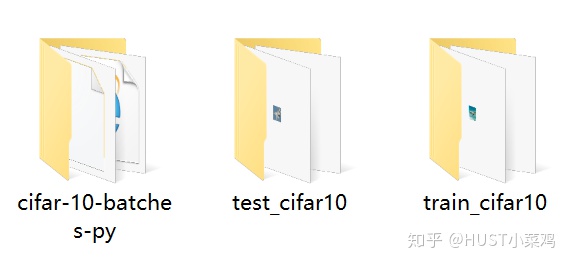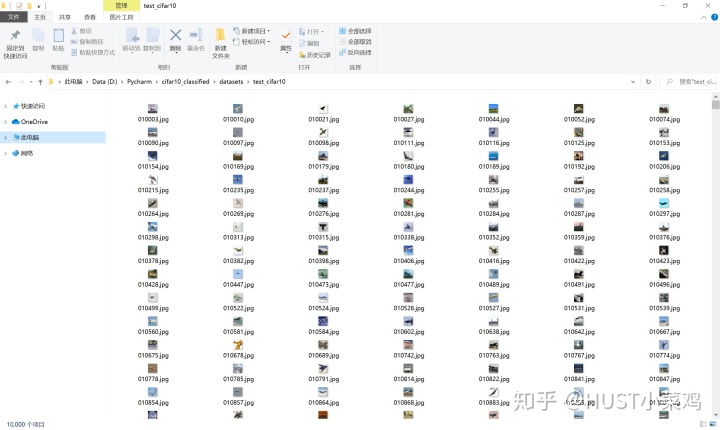一、CIFAR10的下载及使用
HUST小菜鸡:CIFAR10数据集下载zhuanlan.zhihu.com为了方便使用,我将转图片和转数据集标注的分开写,便于理解。后面我会附上同时转数据集为图片及标注文件的代码
二、将数据集转换成图片保存至指定文件夹
#官方给出的python3解压数据文件函数,返回数据字典
运行后将结果转换成了图片
D:Pycharmcifar10_classifiedvenvScriptspython.exe D:/Pycharm/cifar10_classified/trans2img.py
./datasets/cifar-10-batches-py/data_batch_1 is processing
./datasets/cifar-10-batches-py/data_batch_1 is done
./datasets/cifar-10-batches-py/data_batch_2 is processing
./datasets/cifar-10-batches-py/data_batch_2 is done
./datasets/cifar-10-batches-py/data_batch_3 is processing
./datasets/cifar-10-batches-py/data_batch_3 is done
./datasets/cifar-10-batches-py/data_batch_4 is processing
./datasets/cifar-10-batches-py/data_batch_4 is done
./datasets/cifar-10-batches-py/data_batch_5 is processing
./datasets/cifar-10-batches-py/data_batch_5 is done
./datasets/cifar-10-batches-py/test_batch is processing
./datasets/cifar-10-batches-py/test_batch is done
Finish transforming to image

三、将数据集标注生成文件保存
anno_loc = './datasets/annotations/'
#判断文件夹是否存在,不存在的话创建文件夹
if os.path.exists(anno_loc) == False:
os.mkdir(anno_loc)
#用于存放图片文件名及标注
train_filenames = []
train_annotations = []
test_filenames = []
test_annotations= []
#训练集有五个批次,每个批次10000个图片,测试集有10000张图片
def cifar10_annotations(file_dir):
print('creat train_img annotations')
for i in range(1,6):
data_name = file_dir + '/' + 'data_batch_' + str(i)
data_dict = unpickle(data_name)
print(data_name + ' is processing')
for j in range(10000):
img_name = str(data_dict[b'labels'][j]) + str((i) * 10000 + j) + '.jpg'
img_annotations = data_dict[b'labels'][j]
train_filenames.append(img_name)
train_annotations.append(img_annotations)
print(data_name + ' is done')
test_data_name = file_dir + '/test_batch'
print(test_data_name + ' is processing')
test_dict = unpickle(test_data_name)
for m in range(10000):
testimg_name = str(test_dict[b'labels'][m]) + str(10000 + m) + '.jpg'
testimg_annotations = test_dict[b'labels'][m] #str(test_dict[b'labels'][m]) test_dict[b'labels'][m]
test_filenames.append(testimg_name)
test_annotations.append(testimg_annotations)
print(test_data_name + ' is done')
print('Finish file processing')
if __name__ == '__main__':
file_dir = './datasets/cifar-10-batches-py'
cifar10_annotations(file_dir)
train_annot_dict = {
'images': train_filenames,
'categories': train_annotations
}
test_annot_dict = {
'images':test_filenames,
'categories':test_annotations
}
# print(annotation)
train_json = json.dumps(train_annot_dict)
train_file = open('./datasets/annotations/cifar10_train.json', 'w')
train_file.write(train_json)
train_file.close()
test_json =json.dumps(test_annot_dict)
test_file = open('./datasets/annotations/cifar10_test.json','w')
test_file.write(test_json)
test_file.close()
print('annotations have writen to json file')


附转图片同时生成标注文件代码
import torch
import torchvision
import numpy as np
import cv2
import os
import json
cifar10 = torchvision.datasets.CIFAR10(
root='datasets',
train=True,
download=False
)
cifar10_test = torchvision.datasets.CIFAR10(
root='datasets',
train=False,
download=False
)
#输出数据集的信息
print(cifar10)
print(cifar10_test)
train_filenames = []
train_annotations = []
test_filenames = []
test_annotations= []
#cifar10 官方给出的解压函数
def unpickle(file):
import pickle
with open(file, 'rb') as fo:
dict = pickle.load(fo, encoding='bytes')
return dict
anno_loc = './datasets/annotations/'
loc_1 = './datasets/train_cifar10/'
loc_2 = './datasets/test_cifar10/'
#判断文件夹是否存在,不存在的话创建文件夹
if os.path.exists(loc_1) == False:
os.mkdir(loc_1)
if os.path.exists(loc_2) == False:
os.mkdir(loc_2)
if os.path.exists(anno_loc) == False:
os.mkdir(anno_loc)
'''
def cifar10_annotations(file_dir):
print('creat train_img annotations')
for i in range(1,6):
data_name = file_dir + '/' + 'data_batch_' + str(i)
data_dict = unpickle(data_name)
print(data_name + ' is processing')
for j in range(10000):
img_name = str(data_dict[b'labels'][j]) + str((i) * 10000 + j) + '.jpg'
img_annotations = data_dict[b'labels'][j]
train_filenames.append(img_name)
train_annotations.append(img_annotations)
print(data_name + ' is done')
test_data_name = file_dir + '/test_batch'
print(test_data_name + ' is processing')
test_dict = unpickle(test_data_name)
for m in range(10000):
testimg_name = str(test_dict[b'labels'][m]) + str(10000 + m) + '.jpg'
testimg_annotations = test_dict[b'labels'][m] #str(test_dict[b'labels'][m]) test_dict[b'labels'][m]
test_filenames.append(testimg_name)
test_annotations.append(testimg_annotations)
print(test_data_name + ' is done')
print('Finish file processing')
'''
def cifar10_img(file_dir):
for i in range(1,6):
data_name = file_dir + '/'+'data_batch_'+ str(i)
data_dict = unpickle(data_name)
print(data_name + ' is processing')
for j in range(10000):
img = np.reshape(data_dict[b'data'][j],(3,32,32))
img = np.transpose(img,(1,2,0))
#通道顺序为RGB
img = cv2.cvtColor(img,cv2.COLOR_BGR2RGB)
#要改成不同的形式的文件只需要将文件后缀修改即可
img_name = loc_1 + str(data_dict[b'labels'][j]) + str((i)*10000 + j) + '.jpg'
annot_img_name = str(data_dict[b'labels'][j]) + str((i)*10000 + j) + '.jpg'
img_annotations = data_dict[b'labels'][j]
train_filenames.append(annot_img_name)
train_annotations.append(img_annotations)
cv2.imwrite(img_name,img)
print(data_name + ' is done')
test_data_name = file_dir + '/test_batch'
print(test_data_name + ' is processing')
test_dict = unpickle(test_data_name)
for m in range(10000):
img = np.reshape(test_dict[b'data'][m], (3, 32, 32))
img = np.transpose(img, (1, 2, 0))
# 通道顺序为RGB
img = cv2.cvtColor(img, cv2.COLOR_BGR2RGB)
# 要改成不同的形式的文件只需要将文件后缀修改即可
img_name = loc_2 + str(test_dict[b'labels'][m]) + str(10000 + m) + '.jpg'
annot_img_name = str(test_dict[b'labels'][m]) + str(10000 + m) + '.jpg'
img_annotations = test_dict[b'labels'][m]
test_filenames.append(annot_img_name)
test_annotations.append(img_annotations)
cv2.imwrite(img_name, img)
print(test_data_name + ' is done')
print('Finish transforming to image')
if __name__ == '__main__':
file_dir = './datasets/cifar-10-batches-py'
cifar10_img(file_dir)
# cifar10_annotations(file_dir)
train_annot_dict = {
'images': train_filenames,
'categories': train_annotations
}
test_annot_dict = {
'images':test_filenames,
'categories':test_annotations
}
# print(annotation)
train_json = json.dumps(train_annot_dict)
train_file = open('./datasets/annotations/cifar10_train.json', 'w')
train_file.write(train_json)
train_file.close()
test_json =json.dumps(test_annot_dict)
test_file = open('./datasets/annotations/cifar10_test.json','w')
test_file.write(test_json)
test_file.close()
print('annotations have writen to json file')





















 745
745

 被折叠的 条评论
为什么被折叠?
被折叠的 条评论
为什么被折叠?








